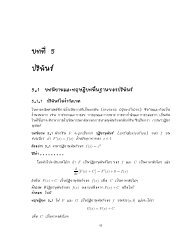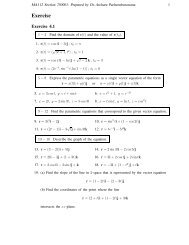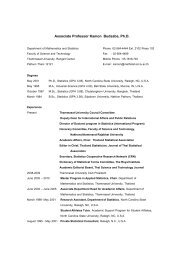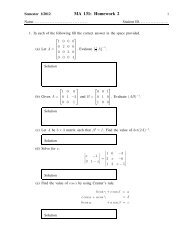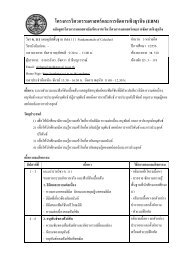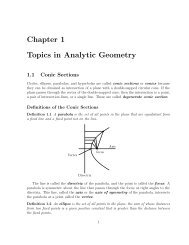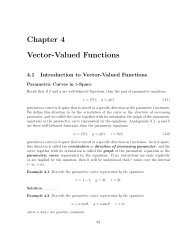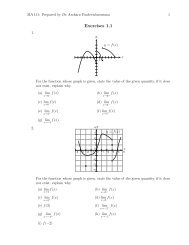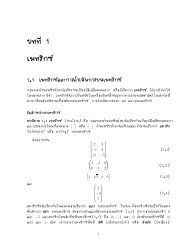Exercise 3.3
Exercise 3.3
Exercise 3.3
You also want an ePaper? Increase the reach of your titles
YUMPU automatically turns print PDFs into web optimized ePapers that Google loves.
MA111: Prepared by Dr.Archara Pacheenburawana 28<br />
3. (a) − 5 , absolute minimum (b) −1, local maximum; 1, local minimum<br />
2<br />
(c) 1, no local extreme values<br />
9<br />
(d) 0, no local extreme values; , local minimum<br />
4<br />
16<br />
(e) 0, no local extreme values; , local minimum<br />
9<br />
(f) − 2 , local minimum; 2, local maximum<br />
3<br />
(g) π, 5π, local maximum; 3π<br />
, 7π , local minimum<br />
4 4 4 4<br />
(h) 1, no local extreme values<br />
(i) −1, local minimum; 1, local maximum<br />
(j) 0, local minimum (k) −2,1, local minimum<br />
(l) − 2 , local minimum (m) 0, local maximum<br />
3<br />
√<br />
3π<br />
(n) 0, , local minimum; √ √<br />
π<br />
, 5π, local maximum<br />
2 2 2<br />
4. (a) f(0) = 5,f(2) = −7 (b) f(1) = 9,f(−2) = 0 (c) f(−3) = 47,f(± √ 2) = −2<br />
(d) f(2) = 3,f(1) = −1 (e) f(1) = 1 2 ,f(0) = 0 (f) f(π/4) = √ 2,f(0) = 1<br />
(g) f(1) = 1/e,f(0) = 0 (h) f(1) = 1,f(3) = 3−3ln3 (i) f(3) = 2,f(1) = 0<br />
(j) f(27) = 3,f(−1) = −1<br />
<strong>Exercise</strong> 3.4<br />
1. Find the intervals on which f is increasing or decreasing.<br />
(a) f(x) = x 3 −3x+2 (b) f(x) = x 4 −8x 2 +1<br />
(c) f(x) = x 6 +192x+17 (d) f(x) = (x+1) 2/3<br />
(e) f(x) = x−2sinx, [0,2π]<br />
(g) f(x) = e x2 −1<br />
(f) f(x) = sin3x, [0,π]<br />
(h) f(x) = (lnx)/ √ x<br />
2. At what values of x does f have a local maximum or minimum Sketch the graph.<br />
(a) f(x) = x 3 +2x 2 −x−1 (b) f(x) = x √ x 2 +1<br />
(c) f(x) = xe −2x (d) f(x) = lnx 2<br />
(e) f(x) = x (f) f(x) = x3<br />
x 2 −1<br />
x 2 −1<br />
(g) f(x) = sinx+cosx (h) f(x) = √ x 3 +3x 2<br />
(i) f(x) = x 2/3 −2x −1/3<br />
3. Show that 5 is a critical number of g(x) = 2 + (x − 5) 3 but g has no local extreme<br />
values at 5.<br />
4. Find a cubic function f(x) = ax 3 +bx 2 +cx+d that has a local maximum value of 3<br />
at −2 and a local minimum value of 0 at 1.



